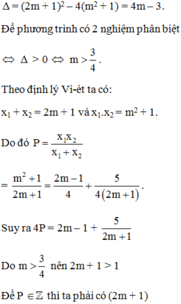Tìm các giá trị của x để biểu thức P(x)=x2+x+8 là một số chính phương.
Hãy nhập câu hỏi của bạn vào đây, nếu là tài khoản VIP, bạn sẽ được ưu tiên trả lời.


Đặt: \(t^2=x^2+x+6\)
=> \(4t^2=4x^2+4x+24=\left(2x+1\right)^2+23\)
=> \(4t^2-\left(2x+1\right)^2=23\)
<=> \(\left(2t-2x-1\right)\left(2t+2x+1\right)=23\)
Chia các trường hợp: => x và t

Bài 1:
a) Ta có: \(P=1+\dfrac{3}{x^2+5x+6}:\left(\dfrac{8x^2}{4x^3-8x^2}-\dfrac{3x}{3x^2-12}-\dfrac{1}{x+2}\right)\)
\(=1+\dfrac{3}{\left(x+2\right)\left(x+3\right)}:\left(\dfrac{8x^2}{4x^2\left(x-2\right)}-\dfrac{3x}{3\left(x-2\right)\left(x+2\right)}-\dfrac{1}{x+2}\right)\)
\(=1+\dfrac{3}{\left(x+2\right)\left(x+3\right)}:\left(\dfrac{4}{x-2}-\dfrac{x}{\left(x-2\right)\left(x+2\right)}-\dfrac{1}{x+2}\right)\)
\(=1+\dfrac{3}{\left(x+2\right)\left(x+3\right)}:\dfrac{4\left(x+2\right)-x-\left(x-2\right)}{\left(x-2\right)\left(x+2\right)}\)
\(=1+\dfrac{3}{\left(x+2\right)\left(x+3\right)}\cdot\dfrac{\left(x-2\right)\left(x+2\right)}{4x+8-x-x+2}\)
\(=1+3\cdot\dfrac{\left(x-2\right)}{\left(x+3\right)\left(2x+10\right)}\)
\(=1+\dfrac{3\left(x-2\right)}{\left(x+3\right)\left(2x+10\right)}\)
\(=\dfrac{\left(x+3\right)\left(2x+10\right)+3\left(x-2\right)}{\left(x+3\right)\left(2x+10\right)}\)
\(=\dfrac{2x^2+10x+6x+30+3x-6}{\left(x+3\right)\left(2x+10\right)}\)
\(=\dfrac{2x^2+19x-6}{\left(x+3\right)\left(2x+10\right)}\)

a. + Với m = − 1 2 phương trình (1) trở thành x 2 − 4 x = 0 ⇔ x = 0 x = 4 .
+ Vậy khi m = − 1 2 phương trình có hai nghiệm x= 0 và x= 4.
b. + Phương trình có hai nghiệm dương phân biệt khi
Δ = 2 m + 5 2 − 4 2 m + 1 > 0 x 1 + x 2 = 2 m + 5 > 0 x 1 . x 2 = 2 m + 1 > 0
+ Ta có Δ = 2 m + 5 2 − 4 2 m + 1 = 4 m 2 + 12 m + 21 = 2 m + 3 2 + 12 > 0 , ∀ m ∈ R
+ Giải được điều kiện m > − 1 2 (*).
+ Do P>0 nên P đạt nhỏ nhất khi P 2 nhỏ nhất.
+ Ta có P 2 = x 1 + x 2 − 2 x 1 x 2 = 2 m + 5 − 2 2 m + 1 = 2 m + 1 − 1 2 + 3 ≥ 3 ( ∀ m > − 1 2 ) ⇒ P ≥ 3 ( ∀ m > − 1 2 ) .
và P = 3 khi m= 0 (thoả mãn (*)).
+ Vậy giá trị nhỏ nhất P = 3 khi m= 0.


a) ĐK:\(\begin{cases} x + 2≠0\\ x - 2≠0 \end{cases}\)⇔\(\begin{cases} x ≠ -2\\ x≠ 2 \end{cases}\)
Vậy biểu thức P xác định khi x≠ -2 và x≠ 2
b) P= \(\dfrac{3}{x+2}\)-\(\dfrac{2}{2-x}\)-\(\dfrac{8}{x^2-4}\)
P=\(\dfrac{3}{x+2}\)+\(\dfrac{2}{x-2}\)-\(\dfrac{8}{(x-2)(x+2)}\)
P= \(\dfrac{3(x-2)}{(x-2)(x+2)}\)+\(\dfrac{2(x+2)}{(x-2)(x+2)}\)-\(\dfrac{8}{(x-2)(x+2)}\)
P= \(\dfrac{3x-6+2x+4-8}{(x-2)(x+2)}\)
P=\(\dfrac{5x-10}{(x-2)(x+2)}\)
P=\(\dfrac{5(x-2)}{(x-2)(x+2)}\)
P=\(\dfrac{5}{x+2}\)
Vậy P=\(\dfrac{5}{x+2}\)

\(a\text{)}\)
\(A=x^2+4x-5=\left(x-1\right)\left(x+5\right)\)
\(\text{Nếu }x\text{ là số tự nhiên lẻ thì }x=2n+1\text{ (}n\in N\text{ )}\)
\(\text{Khi đó: }A=\left(2n+1-1\right)\left(2n+1+5\right)=2n.\left(2n+6\right)=4n\left(n+3\right)\)
+ \(n\text{ chẵn thì }n\left(n+3\right)\text{ chẵn }\Rightarrow n\left(n+3\right)\text{chia hết cho 2 }\Rightarrow4n\left(n+3\right)\text{ chia hết cho 8}\)
+ \(n\text{ lẻ thì }n+3\text{ chẵn }\Rightarrow n\left(n+3\right)\text{ chia hết cho 2 }\Rightarrow4n\left(n+3\right)\text{ chia hết cho 8}\)
Ta có đpcm.
\(\text{b)}\)
\(x^2+65=y^2\)\(\Rightarrow y^2-x^2=65\Leftrightarrow\left(y+x\right)\left(y-x\right)=65.1=13.5\)
\(\text{Do }x,y\text{ nguyên nên }y+x;y-x\text{ nguyên}\)
\(\text{Mà }y+x>y-x>0\text{ nên ta có:}\)
\(\text{+TH1: }y+x=65\text{ và }y-x=1\Leftrightarrow x=32;y=33\)
\(\text{+TH2:}y+x=13\text{ và }y-x=5\Leftrightarrow x=4;y=9\)
\(\text{Vậy }x\in\left\{4;32\right\}\text{ thì }x^2+65\text{ là số chính phương.}\)

đk: x #1;
P = 1 + 9/x-1.
Vậy x nguyên để x- 1 là ước của 9
Ư của 9 là: -9; -3; -1; 0; 1; 3 và 9
Từ đó tìm được x

